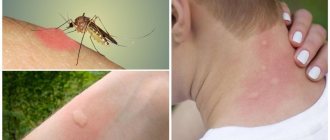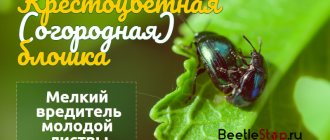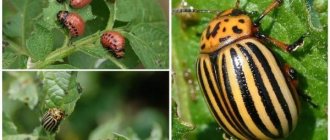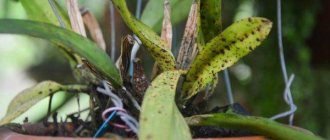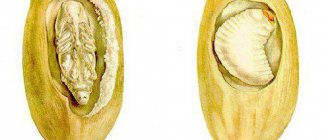Description of ticks and their types
The spider mite (Tetranychus urticae) belongs to the genus of arachnids and includes over 1000 species of arthropods that are distributed throughout the planet, except Antarctica. Of all the species, only 35 parasitize Orchids. Appearance of the insect:
- the body of the arthropod is oval, up to 1 mm in length;
- each species has its own color from yellow-green to red-brown, sometimes whitish;
- there are specimens with 2 dark spots on the body;
- type of oral apparatus – piercing-sucking;
- adults have 4 pairs of legs, larvae - 3 pairs;
- The antennae that most insects have are absent in mites.
The plant can also be affected by other types of mites, such as false spider mites and flat beetles. They require a different environment to reproduce. Types of parasites most often found on plants:
- Ordinary . The body of the insect is soft, flat below, slightly convex above. The size of females is 0.4-0.6 mm, males - 0.3-0.45 mm. The color of the larvae is green or brown, transparent. They have 6 legs; as they mature, their number increases to 8, and their color changes to orange or red.
- Armored . The size of the insect is 0.7-0.9 mm, the color is black or dark brown. The parasite lives in the ground, lays eggs on rotten root systems and fallen leaves, although it runs throughout the orchid. It feeds on dead parts of the plant, so it is sometimes useful. It runs fast, and while moving, many different microorganisms accumulate on its paws and body, which can have a detrimental effect on a houseplant. Oribatid mites do not like light, so they always hide.
- Oncidium (flat) . The body length of the arachnids is 0.3 mm, the shape is ovoid, the color is orange or red. The color of the eggs is red. The insect not only damages the leaf blade, but also injects poisonous saliva into the leaf epithelium.
- Carmine . The body shape of the insect is ellipsoidal, the color is burgundy or brown. Nymphs can be recognized by their yellow and light green shades. The color of the larvae and eggs is red.
- Turkestan . This species is similar in external structure and size to the common tick. Its color varies from yellow to green shades. With the arrival of spring and autumn, the color of the females acquires a bright red hue.
- Greenhouse flat beetle . Red flat mite is what orchid growers call it because the nymphs, larvae and eggs can be any shade of red. The body shape of an adult is ovoid, the color is dark red. The back is covered with a honeycomb pattern.
- Phalaenopsis flat beetle . Due to its small size, the flat beetle is practically invisible. Hides in the axils and folds of leaf plates, on the root system. It affects not only phalaenopsis, but also other Orchid species. The size of males does not exceed 0.27 mm, females - 0.3 mm. Unlike the greenhouse flat beetle, it has 2 antenna-shaped bristles, which are located on the back of the abdomen. The eggs and larvae are red.
- Bulbous . It is impossible to detect the pest, since it affects the root system of the plant or lives at the very base of the stem. The body shape of the arthropod is oval, the color is white or pale yellow. The legs are strong and brown.
Note! You can distinguish spider mites from flat ones by their anatomical structure. The body of flat arthropods is divided by transverse scars and consists of 3 parts: anterior, middle, posterior.
What is an oribatid mite?
Ticks look like small beetles that quickly hide when they sense danger. Such insects prefer to live in a humid environment where sunlight does not reach. Ticks are arthropods but feed on decaying organic matter. Such insects live in colonies. Oribatid mites, photos of which are presented below, play an important role in nature. They regulate the decomposition of mushrooms, greens and algae.
The described species of mites is not considered to reproduce rapidly, but they are usually called long-lived. Only one stage of egg development takes from 1 month to 2 years. An important nuance is that the tick is not considered parasitic.
Insect activity
Ticks got their name from the art of weaving webs. Another species of arthropod does not have this ability. Because of this, they began to be called false or red ticks (Tenuipalpus pacificus). Arachnids feed on plant sap. They bite through the leaf, inject a special liquid inside it, which, when it enters the epithelium of the leaf membrane, forms a nutritious juice. This activity of mites is reflected on plant leaves as follows:
- they gradually turn yellow;
- sometimes small translucent dots appear on the surface of the leaf plate;
- the leaf begins to rot or dry out.
The more greenery an orchid loses, the worse photosynthesis becomes. The development process slows down, then stops and after some time the plant dies. In addition, the appearance of the flower deteriorates greatly if a colony of pests instead of leaves attacks the peduncles.
Conditions for reproduction
For arachnids to reproduce, temperatures above 25 degrees, dry air and a humidity level of up to 40% are required. Ticks go through 5 stages of development :
- The female lays eggs in groups of 200 each. The number of groups may vary. The eggs are round in shape and have a diameter of 0.15 mm. The masonry is located in different places. Usually this is the root system of plants, the underside of leaves, even the walls of the pot and the windowsill.
- After 3 days, a pink larva appears. It is slightly larger than an egg and has 6 legs. The arthropod remains in this stage for 24 hours.
- Then comes the nymph stage. A female individual goes through 3 molts and 2 periods of development, a male – 3 moults and 1-2 periods of development.
- After 7 days, the larva turns into an imago (adult) and is ready to reproduce. The female is slightly larger than the male.
The lifespan of the parasite lasts 15-30 days, if environmental conditions contribute to this. At a temperature of 20 °C, the arachnid will need up to 20 days to develop. The warmer the room, the faster the adult insect appears. The development stage takes no more than 8 days at air temperatures from +25 to +30 °C. Flat beetles do not require special conditions for reproduction if they are in closed ground. Their development occurs all year round.
Important! If the conditions in which the egg laying is poor, the development process is suspended. Their vital functions can be restored again even after 4-5 years.
Hitting the house
Penetration of arachnids into a human home occurs in different ways:
- with a new plant brought from a flower shop;
- through soil contaminated with eggs and larvae;
- through street clothes;
- Sometimes insects fly into the house on a cobweb through an open window.
Optimal conditions for the appearance of mites on orchids
Spider mites prefer dry air and high temperatures, so they attack weakened plants kept in such conditions. They reproduce in closed ground when the thermometer is not lower than 12 degrees Celsius. About 20 generations are produced annually, the full development cycle of one generation lasts from 12 to 20 days, and it decreases with increasing air temperature. The optimal range is 28–32 degrees above zero with air humidity no more than 45–50%, when the complete transformation into an adult spider mite occurs in 6–6.5 days.
Flat beetles develop year-round in closed ground and do not show any special preferences for environmental conditions. Increasing air humidity, which slows down the development of spider mites, is not always effective for flat beetles.
The bulb mite develops more actively at high indoor temperatures, for example, at 26–28 degrees, the full cycle from egg to adult is 10–11 days, while at 20 degrees it takes more than 2 weeks.
Arthropods enter a room in several ways:
- with contaminated substrate;
- with a new specimen of the orchid collection purchased at a flower shop or arrived from a greenhouse;
- with a gust of wind through an open window;
- on the clothes of a person who stopped next to the affected plant.
Symptoms of the lesion
Since the mite is small, it can only be seen on the plant with a magnifying glass or other optical device. One of the main symptoms signaling the appearance of a pest is the web . In addition, there are several other characteristic signs by which you can understand that the orchid is infected with a parasite:
- The back side of the leaf blade is covered with a thin web, under which colonies of small insects are located.
- The surface of the leaf is strewn with white spots, which gradually increase in size. This is how the leaf tissue dies at the bite sites.
- The leaves curl and then gradually dry out.
- The flower slowly fades.
Note ! Mostly, ordinary green, white or red (false) mites infest home orchids.
Locations of parasites and the damage they cause
Arthropods require a lot of food, so they settle on the juiciest parts of the plant:
- on the stem;
- leaves;
- inflorescences.
To get to the nutritious juice, the mite makes several tiny holes in the leaf blade into which air enters. The focal area is covered with a silvery coating, and a cobweb is formed. Then yellowness appears. It quickly affects the entire surface of the leaf, after which it falls off. The buds will also quickly dry out and fall off after all the pests have moved onto them. In addition, spider mites become a source of spread of various fungal, viral and bactericidal infections. You can tell that a plant is infected by the dark and wet spots that appear on the leaves.
Important! If pests have attacked the buds, it means that their colony has increased significantly. In this case, you should immediately begin to destroy them, otherwise the orchid will quickly die.
Infection during flowering
How severely a flowering orchid will suffer from mites depends on the number of parasites. If the plant is in a neglected state, you will have to use chemicals. At the same time, you need to know that chemistry has a strong effect on the thin, delicate petals of flowers; after treatment, flowering will stop. It is much easier to deal with the problem if the arthropods were noticed at the initial stage of reproduction. You can get rid of them using simple methods:
- wipe the leaf blades and trunk with laundry soap or medical alcohol;
- rinse the plant under a hot shower.
Such actions will prevent mites from taking over the entire plant. If treatment is not carried out, then after capturing the green mass they will spread to flowers and buds.
"Fitoverm"
When thinking about how to get rid of orchid mites, you can also pay attention to chemicals. However, you don't need to rely too much on them. Ticks are not particularly susceptible to the effects of such drugs, so after a while they will appear again. Of the known means you need about. They can be used to spray and water plants.
This product is made from the results of the life activity of soil inhabitants. The drug is not considered particularly toxic, so treatment is allowed indoors. This drug has an excellent effect on ticks and larvae. To treat the plant, you need to dilute 2.5 ml of Fitoverma and 1.25 ml of water. The plant needs to be treated 4 times every week.
How to get rid of cobwebs
The mass spread of the pest can be recognized by the cobwebs that appear on the flowers. But sometimes it is difficult to notice, since spider mites weave white webs. The first measures to be taken when it is detected:
- Isolate the flower from other house plants.
- All damaged leaves and buds are cut off and the bulb is removed.
- The roots are cleared of soil and carefully examined. All rotten, dry and damaged parts are cut off.
- All parts of the plant are washed with a solution based on laundry soap, then treated with an insecticide.
- When the orchid dries, transplant it into new soil.
Important! Most of all, ticks like to attack young shoots. Since these parts of the plant contain the bulk of the nutrients, they cannot be completely cut off. Therefore, the shoots are partially cut off or treated with an insecticide.
How to recognize
It is very difficult to visually detect an individual individual due to its small size. This can be done by careful examination using a magnifying glass or under a microscope. More often, gardeners become aware of the presence of an insect when there are already large clusters. Custom
Fitoverm
spruces on the underside of leaves.
When you press firmly on the white webs, a reddish liquid appears - the result of crushed oviposition.
In places where the tick appears, yellow spots, a white powdery coating that looks like a fungal disease, and white cobwebs form.
In advanced cases
Aktellik
ь becomes black. After a certain period, the affected area of the plant dries out and dies, leaving behind depressions and holes.
Ways to fight
You can get rid of spider mites using traditional methods or chemicals. Folk remedies are more gentle and are used for small numbers of arthropods. Chemicals have a strong killing effect, so they are used if the colony of parasites has increased.
Folk remedies
Infusions and decoctions prepared from insecticidal plants are used as folk remedies. Before using them, wipe all parts of the plant with soapy water. This will eliminate most insects, larvae and eggs. To prepare the solution, you need to dissolve 1 tablespoon of grated laundry soap in 1 liter of water. The flower pot and the pallet on which it stood must also be treated. Preparation and use of various means:
- From cyclamen tubers . The tubers are cut into 2-3 parts, placed in a container with boiling water and boiled for 40 minutes. Then the solution is infused for 24 hours. The plant is sprayed with the prepared tincture 2 times with an interval of 5 days.
- From dandelion roots . Dandelion roots - 30 g, finely chopped, pour 1 liter of cold water, leave for 2-3 hours. You can buy roots at the pharmacy.
- From garlic . 170 g of garlic cloves are crushed in a garlic press. Then transfer to a dark container, add 1 liter of water, close tightly, and leave for 5-6 days. 6 g of the resulting concentrated solution is diluted in 1 liter of water. The tincture is poured into a spray bottle and the plant is sprayed every 5 days. The procedure is repeated 2-3 times.
- From a bow . Chop one small onion, add 1 liter of water, seal it tightly, and leave for 7 hours. Instead of an onion, you can use 6 g of husk.
An infusion of dandelions helps well in the fight against orchid mites.
Medical alcohol has worked well in the fight against mites , but it is suitable for plants with thick, hard leaves. The action of alcohol causes burns, so before using it, you should test it on one sheet. If all is well, then soak a cotton swab in alcohol and wipe the rest of the greens with it.
Interesting! You can purchase predatory mites at a flower shop. These beetles are biological control agents and destroy all harmful insects on the plant. When all spider mites are eliminated, the predators will die.
Chemicals
The aversectin group of chemicals against arachnids ( actellik, fitoverm, actofite ) are gentle on humans, which is why gardeners recommend using them at home. The disadvantage of these drugs is that they destroy only adult individuals and do not harm eggs, larvae and protonymphs. Because of this, plant treatment has to be repeated 5 times. Description of drugs:
- Fitoverm is a natural insecticide. After use, the drug quickly decomposes in the air and on the soil surface. Since it contains soil microorganisms (fungi), it does not harm the environment. It is enough for the drug to enter the arthropod’s body or its intestines for paralysis to occur. After some time, the tick dies. If the plant is completely immersed in the prepared Fitoverm solution, the effect of the drug will be more effective.
- Apollo - the drug is intended to destroy spider mites and red mites. The main active ingredient is clofentesine, which is safe for bees and the plant itself. Apollo does not kill adults, but only sterilizes them. Effectively copes with the destruction of larvae and eggs. The effect of the drug lasts from 2 to 3 months. Preparation of the solution: take 2 ml of the substance from the jar with a syringe and dilute it in a small amount of water. Then the drug is stirred in 5 liters of water. The prepared solution is sprayed onto the plant. The procedure is carried out 2 times.
- Antiklesch and Fufanon - these two drugs are equally effective, since they contain the same active ingredient - malathion. It becomes very toxic when it enters the body of an insect. 5 ml of the substance are diluted in 5 liters of water. The prepared solution is poured into a spray bottle and sprayed onto the diseased plant. These drugs belong to hazard class 3 and are toxic to bees and other beneficial insects.
- Thiophos is available in the form of an oily liquid with a pronounced garlic odor. The color is dark brown. The main active ingredient is parathion and NIUIF-100. You should not use this drug at home as it is very poisonous. It is used only on an industrial scale.
- Neoron is a highly effective contact action acaricide. The main active ingredient is bromopropylate. Plants are treated by spraying. Pests die instantly, and the protective properties of the drug continue to operate for another 40 days. The drug affects not only adults, but also eggs and some larvae. When re-processed, it completely destroys them. The substance does not penetrate the epithelium of plants and is harmless to bees and other beneficial insects.
- Actellik - the product belongs to the class of organophosphorus compounds. The main active ingredient is pirimiphos methyl. Actellik is an enteric contact poison. When the parasite enters the body, it affects its neuromuscular system, disrupting the functioning of all organs. The victim dies within a few hours. The drug is more effective at temperatures +15…+25 °C. The drug must be used strictly according to the instructions, outdoors, since it is a highly toxic chemical substance. After using it, the result is noticeable within 1-2 weeks.
To combat flat beetles, you can use drugs called Vermitek, Fozalon, Ambush, Akrex, Tsimbush. The concentration of the substance should not exceed 0.08%. The flat phalaenopsis mite hides in secluded places and builds nests with eggs in the root system. Usually the chemical solution will not get into such places, so it is difficult to get rid of the parasite. Tick larvae continue to crawl out even after 2-3 treatments.
Note! Spider mites have the ability to develop immunity to certain chemicals, so when re-treating, you should use other means.
Danger to plants
Flower growers believe that the oribatid mite is a harmful insect that needs to be eliminated. In fact, in small quantities it will be useful. This is due to the fact that the tick feeds on dead organic matter, moss, and so on.
Damage will occur if there are a lot of insects on the plant. Moreover, sometimes ticks absorb helminth eggs. In some cases, worms hatch directly in ticks, this is dangerous.
Orchid mites are most often found on orchids. If this happens, it means there is too much moisture in the soil. Watering should be reduced, otherwise the orchid may die. Mites are the result of gardener mistakes in the process of caring for the plant.
Preventive measures
To prevent the orchid from being re-invaded by parasites, it is necessary to follow simple preventive measures to care for the plant. Basic Rules:
- The new orchid is kept in quarantine for 14 days, only then placed with the rest of the plants. At the same time, it is treated with an insecticide against insects with which it may be infected.
- You should not take soil for flowers in a flower bed in the yard; parasite larvae often live in such soil. Substrate for phalaenopsis must be purchased in the store. It is of good quality and is disinfected.
- Several times a week, the orchid is inspected for pests, and the leaf blades and trunk are wiped with a disinfectant solution.
- Plants should not stand close to each other, otherwise parasites will appear in them.
- It is necessary to regularly ventilate the room.
- Do not over-moisten the substrate or allow it to dry out completely.
- You need to water the orchid so that no drops of water remain on the inflorescences.
- The air in the room should always be humid.
- Remove fallen leaves and flowers in a timely manner.
Most often, weakened plants suffer from insect attacks. Due to poor care or unsuitable environmental conditions, their immunity decreases, after which the orchid becomes ill. Therefore, before purchasing a plant from the Orchid family, it is necessary to study its physiological characteristics and find out what kind of environment it requires.
Let's sum it up
The tick parasite causes a lot of trouble for gardeners. It settles on the vegetative parts of orchids and feeds on plant sap, gradually leading to the death of the flower crop.
It is not possible to get rid of the pest and cure a houseplant using folk remedies alone. This method of control can become an additional therapy to the use of insecticidal chemicals. The best way is not to treat, but to protect your home orchid from mites by taking preventive measures in time and preventing its spread.

